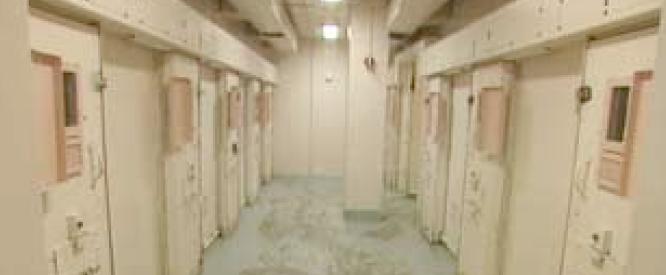
The conditions that I found on the ninth floor of the Miami Dade Detention Center were shocking, but does Virginia treat its prisoners with mental illnesses any better? How about your state?
If you’ve read CRAZY: A Father’s Search Through America’s Mental Health Madness, you know that inmates in Miami’s C wing were housed under what jail officials admitted were “medieval” conditions. Stripped naked, as many as five or six men were held in two man cells that were bone chilling cold because of a design flaw. Often the water didn’t work, so thirsty prisoners drank from toilets. The day I accompanied the jail’s part-time psychiatrist on his rounds, he spoke to each prisoner an average of 12.5 seconds.
So how do jails in my own state compare?
I became curious when I recently invited by the state Department of Behavioral Health and Developmental Services to attend a two day meeting held to discuss collaborative ways for law enforcement, judges, and mental health providers to work together. I’m a strong proponent of jail diversion — getting persons with mental illnesses out of jails and into community treatment so I was eager to attend.
What I discovered is that Virginia is taking baby steps. A majority of police departments are either developing or have Crisis Intervention Team training in place. Even more exciting, under the leadership of Chief Doug Middleton, Henrico County has opened a Crisis Recovery Center at Parham Doctors Hospital were officers can take clearly disturbed individuals to be evaluated and triaged without them becoming entrapped in the criminal justice system. The police take an average of two persons per day to the drop off center. Thirty percent of arrivals are connected to community based treatment services and released. Another thirty percent voluntarily enter local hospital wards for in patient treatment. Forty percent are taken before a judge for an involuntarily commitment hearing.
The recovery center has diverted an average of five persons per month into treatment rather than having officers dump them in jail. At that rate, the county will potentially save a minimum of $120,000 per year. More important, the recovery center is helping people get better rather than having them warehoused in a jail.
That’s the positive news!
Here’s the troubling news. Despite volumes of gushing reports about the effectiveness of mental health courts, Virginia judges continue to drag their feet when it comes to creating specialty dockets. They remain under the mistaken notion that specialty courts increase costs and turn jurists into social workers.
When will our judiciary wake-up and catch-up to what dozens of states, such as Ohio, Texas, and Washington, are doing?
What about our jails? The most comprehensive report about Virginia jails was published in late 2012 by the Senate Finance Committee of the state legislature and it reported that 26,669 inmates were being held in 64 jails and jail farms. 39 percent of women prisoners were reported to have a mental illness. 22 percent of the men did. That means 6,322 inmates were known to have a mental illnesses. Half of those 6,322 prisoners or 3,161 of them had serious mental illnesses, such as schizophrenia and bipolar disorder.
Actually, this number is probably higher. Why? Because only half of our state’s jails bother to ask prisoners if they have been diagnosed with a mental disorder. The truth is that in Virginia, we really don’t know.
What we do know is that only one-third of Virginia jails have separate mental health units or beds segregated from the general jail population. Those separate facilities have 541 beds set aside. That’s 541 beds for 3,161 inmates with serious mental illnesses who have committed a crime..
Where are the other 2,620 prisoner housed? 742 of them were being kept in isolation cells typically used to punish inmates. Many are stripped naked and kept in cells for up to 24 hours. Now that sounds a lot like Miami to me.
To recap, we really don’t know how many prisoners have mental illnesses because only half of Virginia jails screen for them. More prisoners with mental disorders are kept in isolation cells than in mental health units. [Isolation cells have been shown to make illnesses worst.]
What kind of treatment do these seriously mentally ill inmates receive in Virginia jails?
The Senate report found that 17,379 hours of mental health treatment was provided to Virginia jail inmates. When broken down, individuals with serious mental illnesses received an average of 3 ½ minutes of treatment in jail. Dig deeper and you will find the actual time that inmates spent with psychiatrists, as opposed to help from jail social workers, CSBs, and Private Contractors was — FIVE seconds per inmate.
Count out loud : one, two, three, four, five.
That’s less than what I observed in Miami.
Imagine for one moment if that psychotic prisoner being held naked in an isolation cell is your son or your daughter. Would you want your child to get more than five seconds with a psychiatrist? Would you want your child to be in a safe environment, not one that will make his/her illness worse?
And before you tell me that it couldn’t happen in your family, think again. It happened in mine and it can happen to someone you love too.
Thankfully, I’m not the only writer who is interested in the plight of prisoners with mental illnesses. Reporter Prue Salasky (Prue Salasky, psalasky@dailypress.com) in Newport News recently published an eye-popping five- part series about jails and mentally ill prisoners.
Is anyone listening?



